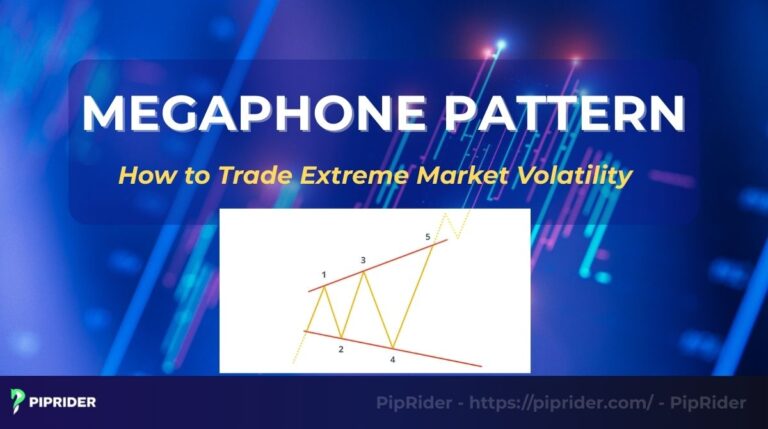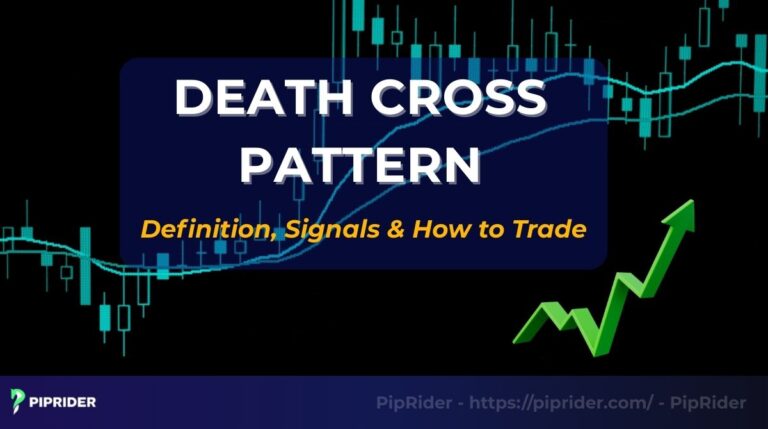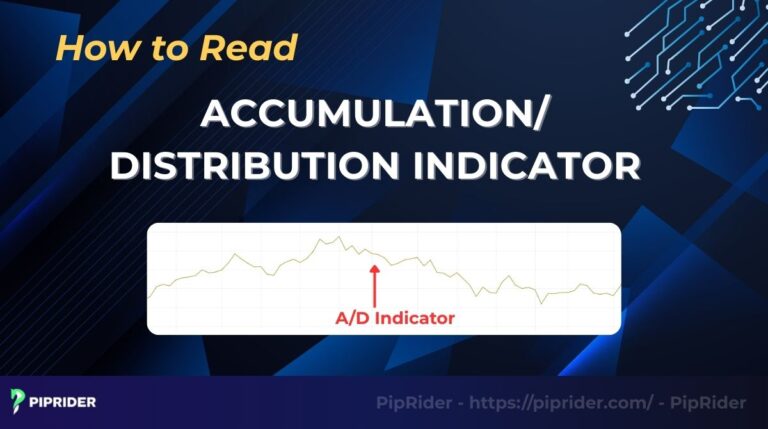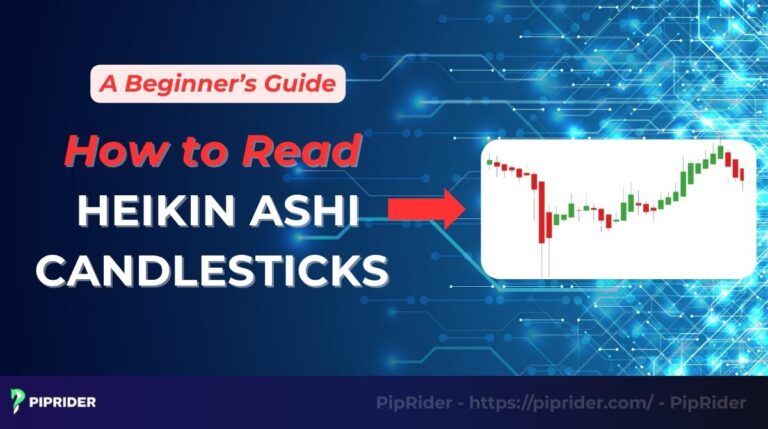The Piercing Candlestick Pattern is a potent, two-candle bullish reversal signal. For experienced traders, merely spotting the pattern is insufficient; its value lies in recognizing the aggressive psychological shift and the technical confluence required for a high-probability trade.
This guide moves beyond basic identification, focusing on the critical validation factors: Volume spikes, market structure, and indicator synergy, that transform this signal into a reliable trade entry. Piprider will detail the precise execution plan to leverage the Piercing Line effectively.
Key Takeaways
- The bullish piercing candle must close above the 50% midpoint of the prior bearish body. This “piercing” action is the core validation of buyer enthusiasm.
- The pattern’s reliability requires alignment with major Support levels and a definitive spike in volume on the second candle.
- Always define the Stop Loss (SL) by placing it just below the Piercing Line’s absolute low.
- The Piercing Candlestick signals a strong rejection of lower prices but does not represent the complete buyer domination seen in the Bullish Engulfing pattern.
1. What Is a Piercing Candlestick Pattern?
The Piercing Candlestick Pattern is a highly regarded, two-candle formation used to signal a bullish reversal following a downtrend (Bajaj Finserv, 2025). Originating from Japanese rice trading techniques, this pattern is foundational in price action analysis, visually communicating a swift and powerful shift in market momentum.
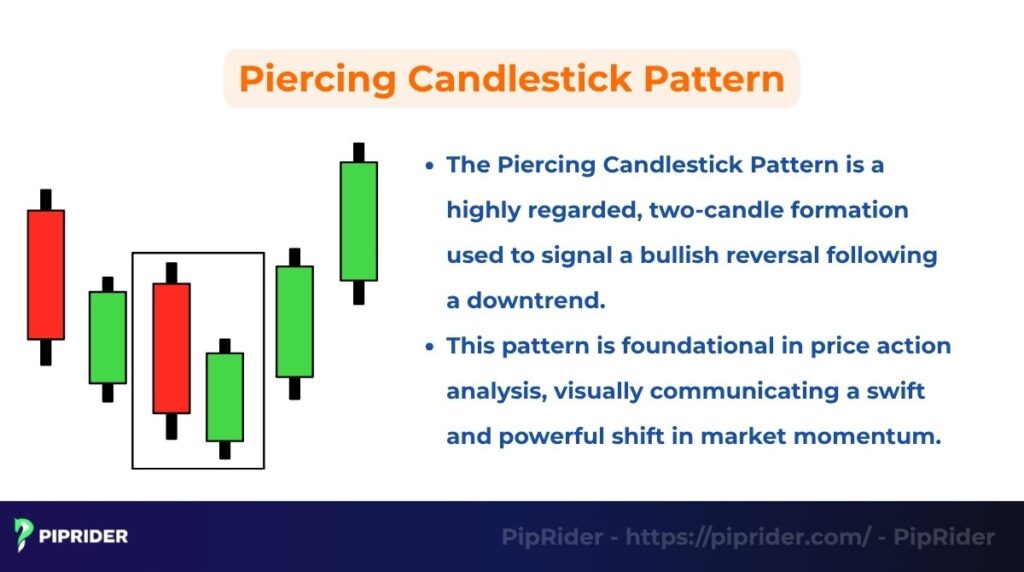
1.1. Key Characteristics
The Piercing Pattern is defined by a strict set of structural rules that experienced market participants rely on:
- Candle 1 (The Setup): A long, bearish (red) candle, confirming the conviction of the sellers and the existing downtrend (Appreciate Trading app, 2025).
- Candle 2 (The Reversal): A long, bullish (green) candle that adheres to two mandatory conditions:
- It must open below the previous close (ideally gapping down, especially in stock markets).
- It must close above the 50% midpoint of the first candle’s real body. This “piercing rule” is the pattern’s critical validation.
- Volume & Position: The signal gains high conviction when accompanied by a spike in volume on the second candle and when it forms precisely at a major support level.
1.2. Significance in a Downtrend Context
The Piercing Pattern signals a decisive psychological and technical failure of the bears. The second candle opens lower, reinforcing selling pressure, but the aggressive close above the 50% midpoint proves buyers have successfully rejected lower prices.
This decisive action marks a powerful, high-probability momentum shift, suggesting a critical market support level has been established and the downtrend is likely exhausted.
2. Understanding the Psychology Behind the Piercing Pattern
The Piercing Line is a key candlestick pattern because it provides a clear visual of a sudden, decisive shift in market control. For experienced traders, it’s not just a shape; it’s the graphical representation of a failed bearish attack and a subsequent, aggressive bullish counter-punch. This shift reflects the changing market sentiment.
- Bear Trap & False Conviction: The initial long bearish candle, followed by the second candle’s gap down open, reinforces bearish conviction, creating a bear trap. This confirms the selling narrative and lures new sellers into opening short positions. This heavy, misplaced bearish commitment becomes the fuel for the subsequent reversal.
- Decisive Bullish Rejection: The aggressive counter-move by the Bulls that closes the price above the 50% midpoint of the prior body is the crucial psychological victory. This action invalidates more than half of the Bears’ recent momentum, forcing late-entering short sellers to cover their positions (Short Covering). This forced buying generates significant upward momentum, propelling the price higher.
- Rapid Supply-Demand Conversion: The Piercing Candlestick Pattern signals a fast and complete conversion from supply to demand. The price action confirms that the asset has hit a point of maximum attractiveness, establishing a firm support level and entirely depleting the selling momentum that defined the previous downtrend.
Read more:
Cup And Handle Pattern: Definition, Strategies & Target
3. Piercing Candlestick Pattern vs. Other Candlestick Setups
Understanding the nuances between reversal patterns is crucial for precise trade execution. The Piercing Line has distinct structural and psychological features that separate it from similar high-probability signals.
3.1. Piercing Pattern vs. Bullish Engulfing
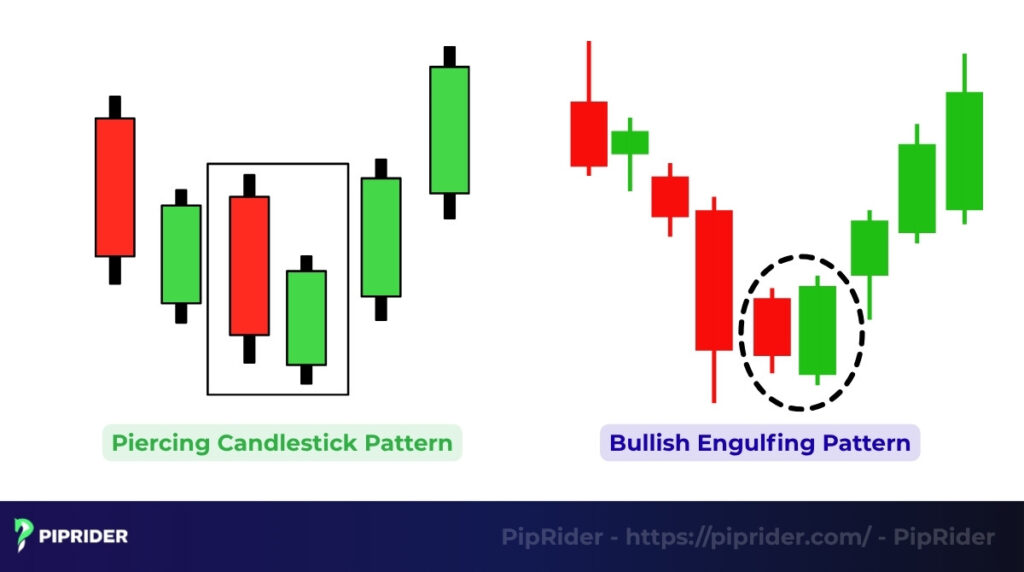
Both are two-candle patterns signaling a major bullish reversal after a downtrend. They both show that buyers have aggressively countered sellers.
| Distinction | Piercing Candlestick Pattern | Bullish Engulfing |
| Coverage (Key Rule) | The bullish candle closes above the 50% midpoint of the prior bearish body. It pierces the body. | The bullish candle’s body completely encompasses (engulfs) the prior bearish candle’s body. |
| Price Action/Reliability | Indicates strong rejection of lower prices and partial invalidation of the bear move. Highly reliable with volume. | Indicates total domination and full invalidation of the bear move. Statistically considered the strongest two-candle signal. |
3.2. Piercing Pattern vs. Dark Cloud Cover
This comparison is mandatory, as the Dark Cloud Cover pattern is the exact opposite (bearish) twin of the Piercing Line. Misinterpreting the context leads to trading in the wrong direction.

- Piercing Candlestick Pattern (Bullish): Appears after a PRICE DECLINE. A bearish candle is pierced by a green candle closing above 50%. (Buy Signal)
- Dark Cloud Cover (Bearish): Appears after an UPTREND. A bullish candle is pierced by a bearish candle closing below 50% of the prior bullish body. (Sell Signal)
Practical Application: Always confirm the preceding trend on a higher timeframe. If the pattern occurs in an uptrend, it is the bearish Dark Cloud Cover. If the pattern occurs in a downtrend, it is the bullish Piercing Candlestick. Context dictates the trade.
4. How to Identify the Piercing Candlestick on a Chart
Identifying the Piercing Pattern accurately requires moving beyond the basic two-candle visual. Experienced traders focus on context and quality to differentiate high-probability setups from market noise. Observing the pattern on the price chart is the first step.
- Timeframe Priority: The Piercing Line’s reliability is significantly higher on Daily (D) or H4 charts, reflecting stronger institutional commitment. Ignore signals on low timeframes (M15, M30) unless strictly confirmed by the higher trend.
- Strongest Confirmation Signals:
- Closing Level: A close at 75% or higher into the prior bearish body (beyond the mandatory 50%) indicates overwhelming buyer strength and is the highest quality signal.
- Volume Spike: The volume on the bullish candle must spike above the average. Low volume suggests a weak, unreliable counter-rally.
- Minimal Shadows: Ideal candles have small shadows, confirming a decisive reversal with minimal price indecision.
- When to Ignore: Reject the Piercing Candlestick Pattern entirely if it appears in a sideways market or after a weak pullback. It must follow a clear, established downtrend. Be wary of a false breakout if the subsequent confirmation candle immediately invalidates the pattern’s low.
5. How to Trade the Piercing Candlestick Pattern
Trading the Piercing Pattern effectively requires a disciplined, multi-step process that prioritizes confirmation and risk management. This strategy focuses on maximizing the signal’s high-probability nature.
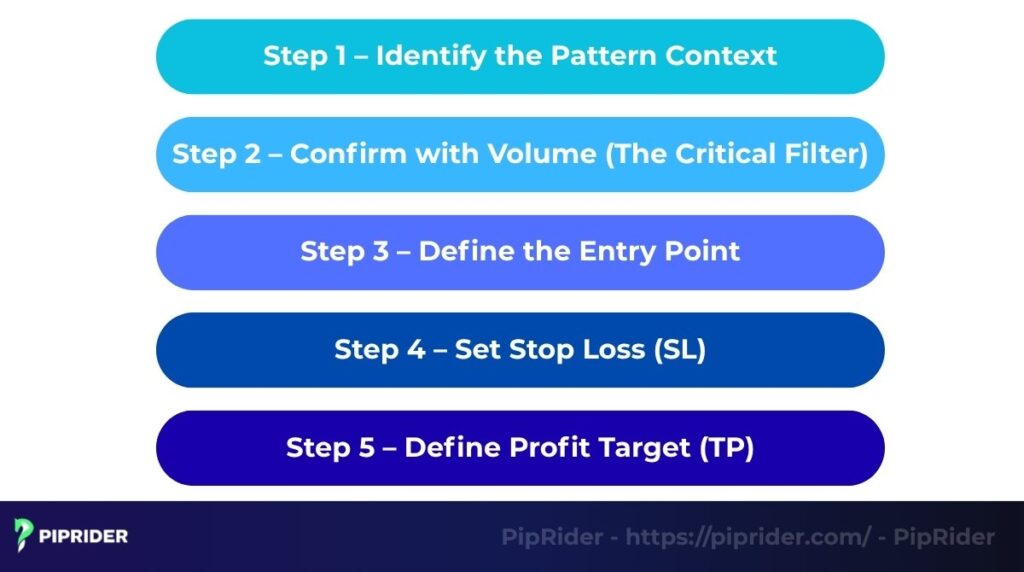
5.1. Step 1 – Identify the Pattern Context
First, verify that the Piercing Candlestick Pattern is forming after a clear and extended downtrend (a series of lower lows). Context is everything. The pattern must ideally appear at a major support zone or a long-term Moving Average to increase its significance.
5.2. Step 2 – Confirm with Volume (The Critical Filter)
Before considering an entry, check the volume. The volume on the second (bullish) candle must be significantly higher than the average volume of the preceding candles. A volume spike validates that the aggressive bullish countermove was driven by institutional participation, confirming a genuine supply-demand shift. Ignore low-volume signals.
5.3 Step 3 – Define the Entry Point
Do not enter immediately upon the close of the bullish candle. Wait for bullish follow-through:
- Entry Trigger: Place a buy stop order or enter a market buy just above the high of the second (bullish) candle. This confirms that the market is ready to resume the rally and has overcome any residual selling pressure at the pattern’s high.
5.4 Step 4 – Set Stop Loss (SL)
Risk management is paramount. Set the Stop Loss (SL) order just below the absolute lowest point of the entire two-candle pattern (usually the low of the second candle’s shadow). This low represents the point of trade invalidation; if breached, the downtrend has resumed.
5.5 Step 5 – Define Profit Target (TP)
Determine your exit strategy using technical structure and a fixed risk-to-reward ratio:
- Structural Target: Aim for the nearest major resistance levels or previous significant swing high.
- R:R Target: Only accept trades that offer a minimum of 1:2 risk-to-reward ratio (e.g., risking 10 pips to gain 20 pips). This ensures profitability even if the win rate is less than 50%.
6. Best Market Conditions for the Piercing Candlestick
The Piercing Pattern is a high-probability setup only when the market context is right. Experienced market participants strictly adhere to these conditions:
- Optimal Environment: Clear downtrend. The pattern is most effective when it follows a strong, established downtrend. The signal loses all validity if it forms during a weak, shallow pullback or minor price correction. Its purpose is strictly to identify a bullish reversal.
- Amplified Strength: Major Support. The signal is significantly stronger (higher conviction) when it appears precisely at a key structural support level (e.g., previous swing low, Fibonacci level, or long-term Moving Average). This confluence confirms institutional interest at that price floor.
- Condition to Avoid: Sideways Markets. The Piercing Pattern is a reversal signal, not a continuation signal. It is not recommended in sideways or range-bound markets (i.e., when the price chart shows a trading range), where it frequently generates false signals and whipsaws.
7. Common Mistakes When Trading the Piercing Candlestick Pattern
Experienced traders must be aware of these critical errors that undermine the reliability of the Piercing Candlestick signal:
- Premature Entry Before Confirmation: The most frequent mistake is entering the trade before the second (bullish) candle has fully closed and confirmed the pierce above the 50% midpoint. Patience is non-negotiable; entering early risks being caught in a failed reversal.
- Ignoring Volume Confirmation: Treating the Piercing Pattern as valid without a corresponding spike in volume is a major oversight. Low volume suggests the move is weak and not institutionally supported, drastically increasing the chance of a false signal.
- Neglecting Higher Timeframe Context: Failing to check the Daily or H4 chart for the larger trend or key structural levels. Trading the Piercing Pattern on a low timeframe against a strong higher timeframe downtrend often results in getting stopped out.
8. Combining the Piercing Candlestick with Indicators
Experienced traders must use technical indicators to create confluence, confirming the Piercing Pattern and increasing its probability. Relying solely on the candlestick pattern is a common, high-risk error, underscoring the necessity of these technical indicators.
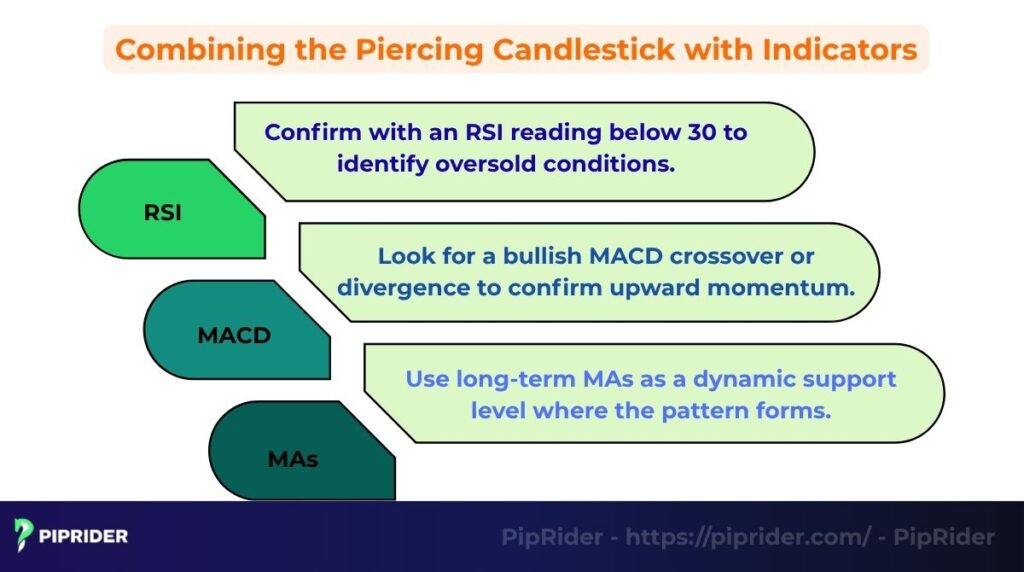
- Relative Strength Index (RSI): Use the RSI to confirm oversold conditions. The signal is amplified when the bullish candle forms while the RSI is below 30. This indicates selling momentum is exhausted, validating the reversal.
- Moving Average Convergence Divergence (MACD): Look for a bullish crossover (MACD line crosses above the signal line) occurring at the same time or immediately after the Piercing Pattern forms. This signals accelerating upward momentum, confirming the sentiment shift. Look also for divergence between the price and the MACD. It provides secondary confirmation.
- Moving Averages (MAs): Use long-term MAs (e.g., 50-period, 200-period) to establish the trend reversal context. The signal is strongest when the Piercing Pattern forms exactly at a major MA acting as dynamic support. Confirmation is also achieved when the subsequent price action breaks above a descending MA, signaling the official trend change.
9. Pros and Cons of the Piercing Pattern
Like any technical signal, the Piercing Candlestick Pattern has distinct advantages and disadvantages that experienced traders must weigh when deciding on a setup.
9.1. Pros
The primary advantages of the Piercing Pattern stem from its clear structure and universal applicability, making it a favored tool for confirming bullish momentum shifts.
- Clarity and Simplicity: The Piercing Pattern is easy to identify with clear, quantitative rules (the 50% pierce). It provides an unambiguous bullish reversal signal that is immediately actionable upon confirmation.
- Versatility Across Markets: The pattern’s underlying psychology (rejection of low prices) applies across various asset classes, making it highly effective in Forex, Stocks, and Crypto markets.
9.2. Cons
The drawbacks mainly relate to signal quality and context, requiring disciplined confirmation to avoid high-risk false setups.
- Susceptibility to False Signals: Piercing Pattern is highly prone to generating false signals if the mandatory volume confirmation is ignored. A weak pierce without a volume spike often leads to an immediate continuation of the bearish trend.
- Reduced Reliability in Weak Trends: The pattern’s conviction significantly decreases when it appears after a shallow pullback or in a weak, range-bound downtrend. It needs strong preceding bearish momentum to validate the reversal’s significance.
10. Frequently asked questions about Piercing Candlestick Pattern
11. Conclusion
The Piercing Candlestick Pattern is a powerful, high-conviction bullish reversal signal when found in the correct context. Its fundamental role is to confirm a decisive psychological failure of sellers and the establishment of a strong market support level. Trading decisions must always follow confirmation.
To transition this signal into a successful trade, the critical takeaway remains: Always utilize multi-factor confirmation. Never trade the pattern in isolation. A high-probability setup requires the strict confluence of: Price Action, Volume, Technical Indicators (like MACD).
Mastering the Piercing Line elevates your market timing and risk control. For continued learning and in-depth reviews of actionable setups, follow our dedicated sections on Forex Chart Patterns and Broker Reviews at Piprider. Don’t forget to define your take profit level before entry.



